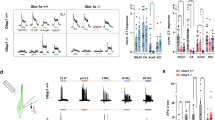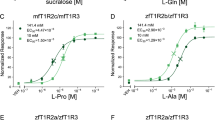Abstract
The sense of taste provides animals with valuable information about the nature and quality of food. Mammals can recognize and respond to a diverse repertoire of chemical entities, including sugars, salts, acids and a wide range of toxic substances1. Several amino acids taste sweet or delicious (umami) to humans, and are attractive to rodents and other animals2. This is noteworthy because l-amino acids function as the building blocks of proteins, as biosynthetic precursors of many biologically relevant small molecules, and as metabolic fuel. Thus, having a taste pathway dedicated to their detection probably had significant evolutionary implications. Here we identify and characterize a mammalian amino-acid taste receptor. This receptor, T1R1+3, is a heteromer of the taste-specific T1R1 and T1R3 G-protein-coupled receptors. We demonstrate that T1R1 and T1R3 combine to function as a broadly tuned l-amino-acid sensor responding to most of the 20 standard amino acids, but not to their d-enantiomers or other compounds. We also show that sequence differences in T1R receptors within and between species (human and mouse) can significantly influence the selectivity and specificity of taste responses.
This is a preview of subscription content, access via your institution
Access options
Subscribe to this journal
Receive 51 print issues and online access
$199.00 per year
only $3.90 per issue
Buy this article
- Purchase on Springer Link
- Instant access to full article PDF
Prices may be subject to local taxes which are calculated during checkout




Similar content being viewed by others
References
Lindemann, B. Taste reception. Physiol. Rev. 76, 718–766 (1996)
Iwasaki, K., Kasahara, T. & Sato, M. Gustatory effectiveness of amino acids in mice: behavioral and neurophysiological studies. Physiol. Behav. 34, 531–542 (1985)
Hoon, M. A. et al. Putative mammalian taste receptors: a class of taste-specific GPCRs with distinct topographic selectivity. Cell 96, 541–551 (1999)
Adler, E. et al. A novel family of mammalian taste receptors. Cell 100, 693–702 (2000)
Chandrashekar, J. et al. T2Rs function as bitter taste receptors. Cell 100, 703–711 (2000)
Matsunami, H., Montmayeur, J. P. & Buck, L. B. A family of candidate taste receptors in human and mouse. Nature 404, 601–604 (2000)
Nelson, G. et al. Mammalian sweet taste receptors. Cell 106, 381–390 (2001)
Kitagawa, M., Kusakabe, Y., Miura, H., Ninomiya, Y. & Hino, A. Molecular genetic identification of a candidate receptor gene for sweet taste. Biochem. Biophys. Res. Commun. 283, 236–242 (2001)
Montmayeur, J. P., Liberles, S. D., Matsunami, H. & Buck, L. B. A candidate taste receptor gene near a sweet taste locus. Nature Neurosci. 4, 492–498 (2001)
Max, M. et al. Tas1r3, encoding a new candidate taste receptor, is allelic to the sweet responsiveness locus Sac. Nature Genet. 28, 58–63 (2001)
Sainz, E., Korley, J. N., Battey, J. F. & Sullivan, S. L. Identification of a novel member of the T1R family of putative taste receptors. J. Neurochem. 77, 896–903 (2001)
Offermanns, S. & Simon, M. I. Gα15 and Gα16 couple a wide variety of receptors to phospholipase C. J. Biol. Chem. 270, 15175–15180 (1995)
Mody, S. M., Ho, M. K., Joshi, S. A. & Wong, Y. H. Incorporation of Gαz-specific sequence at the carboxyl terminus increases the promiscuity of Gα16 toward Gi-coupled receptors. Mol. Pharmacol. 57, 13–23 (2000)
Tsien, R. Y., Rink, T. J. & Poenie, M. Measurement of cytosolic free Ca2+ in individual small cells using fluorescence microscopy with dual excitation wavelengths. Cell Calcium 6, 145–157 (1985)
Nakanishi, S. Molecular diversity of glutamate receptors and implications for brain function. Science 258, 597–603 (1992)
Kaupmann, K. et al. Expression cloning of GABAB receptors uncovers similarity to metabotropic glutamate receptors. Nature 386, 239–246 (1997)
Speca, D. J. et al. Functional identification of a goldfish odorant receptor. Neuron 23, 487–498 (1999)
Yoshii, K., Yokouchi, C. & Kurihara, K. Synergistic effects of 5′-nucleotides on rat taste responses to various amino acids. Brain Res. 367, 45–51 (1986)
Fuller, J. L. Single-locus control of saccharin preference in mice. J. Hered. 65, 33–36 (1974)
Lush, I. E. The genetics of tasting in mice. VI. Saccharin, acesulfame, dulcin and sucrose. Genet. Res. 53, 95–99 (1989)
Bachmanov, A. A. et al. Positional cloning of the mouse saccharin preference (Sac) locus. Chem. Senses 26, 925–933 (2001)
Bachmanov, A. A., Tordoff, M. G. & Beauchamp, G. K. Intake of umami-tasting solutions by mice: a genetic analysis. J. Nutr. 130, 935S–941S (2000)
Bachmanov, A. A., Tordoff, M. G. & Beauchamp, G. K. Sweetener preference of C57BL/6ByJ and 129P3/J mice. Chem. Senses 26, 905–913 (2001)
Ikeda, K. On a new seasoning. J. Tokyo Chem. Soc. 30, 820–836 (1909)
Kurihara, K. & Kashiwayanagi, M. Introductory remarks on umami taste. Ann. NY Acad. Sci. 855, 393–397 (1998)
Chaudhari, N., Landin, A. M. & Roper, S. D. A metabotropic glutamate receptor variant functions as a taste receptor. Nature Neurosci. 3, 113–119 (2000)
Dahl, M., Erickson, R. P. & Simon, S. A. Neural responses to bitter compounds in rats. Brain Res. 756, 22–34 (1997)
Acknowledgements
We thank W. Guo for help generating various T1R expression constructs, and A. Becker for help with tissue culture and antibodies. We are grateful to S. Simon and R. Erikson for teaching us the nerve-recording preparation. We also thank L. Stryer and members of the Zuker lab for help and advice. This work was supported in part by a grant from the National Institute on Deafness and Other Communication Disorders to C.S.Z. C.S.Z. is an investigator of the Howard Hughes Medical Institute.
Author information
Authors and Affiliations
Corresponding author
Ethics declarations
Competing interests
The authors declare that they have no competing financial interests
Rights and permissions
About this article
Cite this article
Nelson, G., Chandrashekar, J., Hoon, M. et al. An amino-acid taste receptor. Nature 416, 199–202 (2002). https://doi.org/10.1038/nature726
Received:
Accepted:
Published:
Issue Date:
DOI: https://doi.org/10.1038/nature726
This article is cited by
-
Characteristics of A-type voltage-gated K+ currents expressed on sour-sensing type III taste receptor cells in mice
Cell and Tissue Research (2024)
-
Structure, function and drug discovery of GPCR signaling
Molecular Biomedicine (2023)
-
The flavor-enhancing action of glutamate and its mechanism involving the notion of kokumi
npj Science of Food (2023)
-
Physiological activation of human and mouse bitter taste receptors by bile acids
Communications Biology (2023)
-
Allosteric modulation of the fish taste receptor type 1 (T1R) family by the extracellular chloride ion
Scientific Reports (2023)
Comments
By submitting a comment you agree to abide by our Terms and Community Guidelines. If you find something abusive or that does not comply with our terms or guidelines please flag it as inappropriate.



